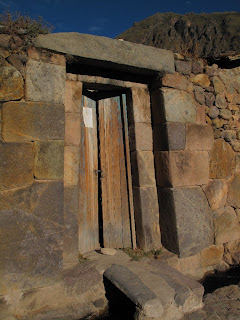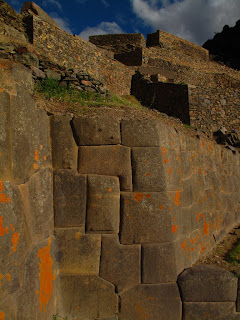After leaving the Sacred Valley we headed south towards Lake Titicaca and Bolivia. Lake Titicaca, also known as the “Sacred Lake”, is located at the ridiculous altitude of 3800 meters (12,350 feet). We first explored the lake from the Peru side, taking a day trip from the lakeside city of Puno. From here we visited the floating islands of Uros and Isla Taquile.
Nowadays the floating islands are primarily a tourist attraction, although the local people do actually live there. We expected the worst in terms of “dog and pony show” but our visit was actually reasonably enjoyable and informative. We were given basic demonstrations about how the islands and buildings are constructed from reeds, how the locals hunt and fish, etc.
We continued to the Island of Taquile, which is a “real” island (not floating) inhabited by approximately 2500 people. Most of the island is covered in terraces built long ago to improve the agricultural situation, and there are only footpaths and many stairs, so no vehicles of any sort (exception: Donkeys). The people here have unique and colorful clothing, and we saw several men knitting their stocking-type caps. After climbing to the top of the island where the main plaza for views and shopping, followed by lunch with a great view of the lake and the western shore. We then walked back down the million steps, got on the boat, and returned to Puno.
We continued south by bus, crossing into Bolivia, transferred to a boat in the town of Copacabana, and headed for Isla Del Sol (Island of the Sun), the largest island in Lake Titicaca. Historically this island is important to the people of Bolivia and Peru, as legend has it this was the birthplace of the first Inca, and even the sun. Somewhat similar to Isla Taquile, this island has about 2500 residents, and donkeys are the only vehicles. It also features some nifty Inca ruins, and pathways and stairways built by the Incas are still in use today. Also, the scenery is great.
After arriving at the island we hauled our gear up 382 steps (yes, we counted) and some uphill as well, to the village of Yumani, where we 1) caught our breath 2) tried to stay out of the way of the donkeys 3) found lodging and 4) enjoyed the great views.
The next morning we set out on a walking tour of the island. As we followed the Inca road north, we were passed by ladies with their flocks of sheep, typically accompanied by a pig or two. We also people with cows, and of course donkeys. Most were very friendly. After passing by a couple of villages and some nice beaches, we arrived at the northern village of Challapampa in time for lunch. Here half the party took the boat south, the other half continued north to visit the ruins and return south by the high road. The ruins were interesting mostly for their spectacular setting high on a peninsula with great views of the lake. With regard to the high road, let me point out the the Incas' favorite direction to go is up, straight up. The road took us directly over the highest parts of the island, which literally takes one's breath away at approximately 4000 meters above sea level. The scenery was not bad, which provided a nice distraction. The next morning it was down the 382 steps with our luggage for the return boat ride. We all appreciated how much easier it was going down than up.
G





















































